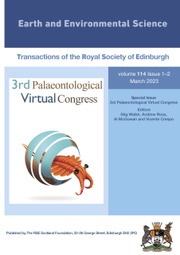Article contents
The anatomy and seed plant affinities of Rhacopteris and Spathulopteris foliage from the Dinantian (Lower Carboniferous) of Scotland
Published online by Cambridge University Press: 03 November 2011
Abstract
Permineralised material of Rhacopteris lindseaeformis (Bunbury) Kidston and Spathulopteris obovata (Lindley & Hutton) Kidston, showing both external morphology and excellent anatomical preservation, is described from the Lower Carboniferous (?Asbian, Upper Viséan) tuffs and dolomitic ashes outcropping at Weaklaw–Gullane, East Lothian, Scotland. These specimens provide the first anatomical information on these two well-known plant compression genera. The rachises have Lyginorachis-type anatomy with distinctive characters in the two species. Spathulopteris rachises correspond to Lyginorachis kingswoodense Meyer-Berthaud, previously described from the localities of Kingswood and East Kirkton, whereas Rhacopteris shows similarities with the petiole attributed to Bilignea from Oxroad Bay. Both foliage types conform to seed-fern frond organisation. This new evidence contradicts previous interpretations of Rhacopteris as a fern or a progymnosperm. We suggest that Rhacopteris lindseaeformis and Spathulopteris obovata represent the foliage of some of the arborescent gymnosperms which are found associated in several contemporaneous localities.
- Type
- Research Article
- Information
- Earth and Environmental Science Transactions of The Royal Society of Edinburgh , Volume 88 , Issue 4 , 1997 , pp. 197 - 208
- Copyright
- Copyright © Royal Society of Edinburgh 1997
References
- 13
- Cited by


